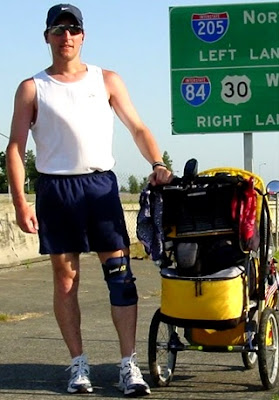During my adventure runs across states and countries, I saw a lot of graffiti. Most of it was pretty rough looking, but occasionally I would come across a wall of graffiti that was pretty elaborate and really showed artistic talent by the person who put it there. In the United States, most of the graffiti that I saw was on the sides of trains, on the cement of underpasses, and on inner city walls. However,
the location where I saw the most graffiti -- and perhaps the most artistic -- was Germany. In fact, Berlin, Germany, is sometimes referred to as the graffiti capital of Europe.
It was near Frankfurt, Germany that I passed a long wall of graffiti and a portion of it read: "Save the Graffiti. We're not just a kind of movement, we're a generation." The person who wrote that clearly had a heart for graffiti.
All U.S. states, as well as many municipalities, have laws that make it a crime to spray graffiti on public property or private property that you do not own or have permission to use. The crime often committed when deploying graffiti is vandalism -- spray painting on somebody else's property without their consent. Anti-graffiti enforcement is expensive. By one estimate, the U.S. spends between 15 and 18 billion dollars a year to monitor, detect, remove, and repair graffiti damage. Also, the penalties can be significant for those applying graffiti. As an example, a graffiti writer in Los Angeles who causes more than $400 in damage to a property can face fines up to $10,000, up to one year in jail, or both. In California, fines are based on the amount of damage done to a property. Also, if a graffiti writer causes more than $50,000 in damage in L.A., they can be fined up to the same amount and see up to one year in jail. Damage totaling less than $400 can carry a fine of up to $1,000 with up to 6 months in jail.
Spray painting graffiti can also be dangerous, and even deadly. Last year in Germany, a person died after a passing train hit him as he was spraying graffiti on a junction box. Also in 2019, a 28-year-old American had been attempting to spray graffiti on a building when he fell through a metal awning and was killed. There are actually many stories of people being killed while attempting to create graffiti.
With this years increase in protests across the U.S., graffiti has boomed in popularity for spreading messages. Churches, national parks, historic locations, and more have been vandalized with graffiti paint as people aim to have their positions, feelings, opinions, and convictions known. During my running adventures I saw people spray painting graffiti -- typically of younger age -- and never engaged in any conversation with them. Along the way I saw historic architecture vandalized with paint and in some instances (particularly in Germany) it appeared that some communities had given up in trying to stop such vandalism. As I had read on a graffiti wall near Frankfurt, Germany -- "We're not just a kind of movement, we're a generation." Sadly, this generation believes that vandalism is acceptable for expressing oneself.
From Him, Through Him, For Him (Romans 11:36),
Paul J. Staso
_______________________________________
Click on any of the links below to see some of my adventure photos:










